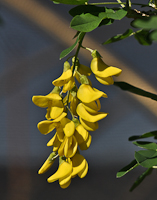 Many plants have adapted
themselves to their harsh environment by making their
seeds extremely tough with hard seedcoats. In nature,
the elements such as rain, freezing and thawing and
microorganisms word on the seedcoat over time to soften
it up. Thus, depending on conditions, some seeds will
germinate the first year while others from the same crop
will wait to the second or third year or longer. This
assures that at least a part of the seed crop will
germinate under desirable conditions and survive.
Many plants have adapted
themselves to their harsh environment by making their
seeds extremely tough with hard seedcoats. In nature,
the elements such as rain, freezing and thawing and
microorganisms word on the seedcoat over time to soften
it up. Thus, depending on conditions, some seeds will
germinate the first year while others from the same crop
will wait to the second or third year or longer. This
assures that at least a part of the seed crop will
germinate under desirable conditions and survive.
The root of the word,
scarification, is scar. This signifies that by some
artificial means, the thick, hard seedcoat is scarred
and opened up so that water may penetrate and
germination may begin.



